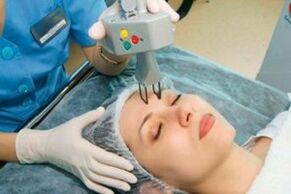
There are many innovative technologies that can keep you young, so that patients sometimes get lost in their choices.
Those who wish to activate the natural process of skin renewal and rejuvenation can provide such an effective procedure, such as partial pyrolysis, during which the upper layer of the epidermis is removed with a laser grinder.
Fractional laser skin rejuvenation is a more effective type of cosmetic surgery that can combat age-related skin changes.
This method has its specific characteristics and techniques, indications and contraindications. Before implementation, you must consult an expert.
Technical Principle
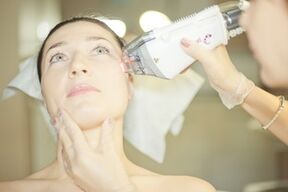
In 2004, American scientists tested the hierarchical pyrolysis technology for the first time. Since then, it has undergone many clinical studies and has become a powerful tool for modern cosmetology. The essence of hierarchical pyrolysis (photothermal decomposition, nano-perforation, fraxel) is to use a special device to separate the laser beam into many ultra-fine fractions.
The process involves the use of very small, targeted laser beams that cause microscopic damage to the treated skin area.
Laser irradiation will increase the local temperature of various areas of the skin, which inevitably leads to the heating of the cell contents and the destruction of the cell structure. In turn, this activates the recovery process, leading to increased fibrin (collagen) production and the formation of new epithelial cells. And the more collagen in the epidermis, the fewer wrinkles and other defects on the skin.
Regarding molecular changes, what needs attention here is the appearance of heat shock protein, hyaluronic acid, and the appearance of transforming growth factor (a special peptide). All these substances will accelerate the use of damaged collagen in cells and form new molecules.
Usually, the top layer of the skin will recover the day after the facelift. The shedding of dead cells ends after about 10 to 12 days.
In every damaged area, intensive recovery begins because nature provides a high regeneration rate for skin tissue. Due to the point effect, a fairly stable supply of healthy cells is formed in the skin as a source of new epithelial cells.
Ablative and non-ablative techniques
When laser pulses are used to help evaporate the active material, it is most likely laser ablation. In ablative photothermal decomposition, laser radiation is used, and its energy is mainly accumulated by water molecules. By briefly acting on the local area, the laser stream immediately raises the temperature of the water contained in the tissue to 300 degrees. At the evaporation site, there will be a small open wound, next to the heat-coagulated epithelial cells.
Compared with non-ablative techniques, this pyrolysis requires a longer recovery time, but the results will look more spectacular. The shortcomings of this method may only be attributed to the risk of infection in the deep tissues of the dermis.
Non-ablative pyrolysis is considered a less invasive surgery. Here, a laser beam is used, which actually reduces the risk of skin damage to zero-burns are formed under it. The destroyed epithelial cells do not evaporate, but are deposited in the dermis, so the patient does not have to deal with open wounds. Firming and rejuvenation are not as obvious as other methods, because dead skin cells will not disappear anywhere, which means that the firming effect is minimal.
Compared with ablation techniques, patients can avoid skin tissue infections because the integrity of the skin's surface layer will not be disturbed during the operation.
Pros and cons
Like plastic correction, partial pyrolysis makes the skin less rough and rough. But if surgery is considered the fundamental way to improve the appearance of the skin, pyrolysis is called mild. Nevertheless, its effectiveness is not inferior. In addition, the scope of tasks solved by partial pyrolysis is even broader than that of contour plastics.
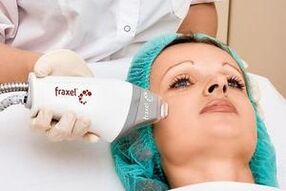
The main advantages of this technology are as follows:
- Recover as soon as possible
- During the operation, the patient will not feel pain;
- The result can be stored for a long time;
- Laser irradiation is equally harmless to any type of skin;
- Even the most sensitive areas of the skin respond well to the laser;
- Lack of strict restrictions during rehabilitation;
- The minimum number of possible side effects;
- The risk of any virus (HIV, hepatitis) causing blood poisoning is zero.
Although pyrolysis is considered a high-tech and safe method, it also has its own side effects, especially:
- Microbial agents penetrate the skin-Staphylococcus and Streptococcus;
- Abnormal redness of the skin;
- Inflammation and fluid accumulation in the skin treatment area;
- Hyperpigmentation, minor burns and cracks, the appearance of acne.
Indications and contraindications
Most of the clients are women of the older generation who desire to smooth out wrinkles and eliminate obvious wrinkles on the face and neck. Of course, the effect will meet all expectations, but in addition, the procedure can also solve other beauty problems, including:
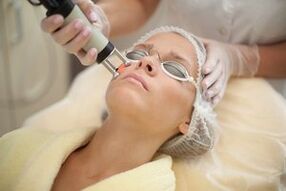
- Eliminate pigmentation, age spots and marks caused by sunlight;
- Smooth out the signs of aging skin;
- Smoothes deep wrinkles;
- Narrowing of pores;
- Eliminate small wrinkles on the eyelids;
- Recovery of the skin that has lost its elasticity;
- Eliminate the consequences of acne;
- Get rid of stretch marks and scars.
In some cases, patients are forced to look for alternative methods of partial pyrolysis, because laser skin rejuvenation can lead to completely opposite results. Therefore, this procedure is contraindicated in the following situations:
- When taking a child
- During lactation;
- As existing diseases worsen;
- Acute respiratory infections, including influenza;
- When there is a malignant tumor;
- If the patient's blood coagulates poorly;
- When the face is covered with many moles;
- If there are inflammatory foci on the skin;
- When there is an autoimmune disease;
- If the patient is receiving certain medications.
Process technology
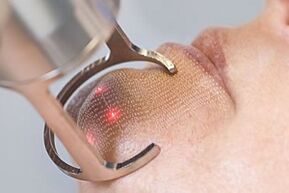
The initial consultation with the beautician is a mandatory stage of any cosmetic surgery. In this stage, the doctor’s goal is to clarify the client’s wishes and inform various nuances.
First, the beautician uses a cotton pad coated with anesthetic cream to treat the patient's skin. Then apply the ointment to the surface of the skin to promote the sliding of the device.
After that, the expert is equipped with equipment with special accessories and starts to deal with the problem area. The applied anesthetic and the flow of cooling air minimize pain and create additional comfort for the patient. With very few exceptions, patients may complain of a slight tingling sensation.
The Fraxel device developed by American scientists has caused a sensation in the field of non-invasive beauty. The experts were given a unique opportunity to use specific nozzles for laser pyrolysis for each specific purpose. In some preparations, only thulium rods are involved, while in other preparations, erbium rods, there are also combined models. Depending on the skin area to be treated, choose one or the other core.
The entire meeting rarely lasts more than thirty minutes. If you need to remove stretch marks on the buttocks and abdomen, it may take longer.
The original Fraxel device had 4 main modes, each of which allowed the laser beam to penetrate to a given depth:
- beautiful. Gentle surface treatment. It is very suitable for treating eyelids, breasts and other sensitive parts of the body.
- Maintain. The thulium rod makes the laser beam penetrate into the skin, can remove deep wrinkles and marks, and regulate the oiliness of the skin. If there are discoloration of blood vessels and open pores, then this kind of repair is the best choice.
- recover. The most popular technology today, it allows you to forget the shallow wrinkles and small scars after acne.
- Restore the double. The procedure is carried out with the simultaneous use of two rods-erbium and thulium. It will help those with obvious scars and scars.
How many treatment courses are needed to achieve significant results depends largely on the severity of the lesion and the specific conditions of the treatment area, but usually at least 5-7 operations are required.
Characteristics of the rehabilitation period
After partial pyrolysis, the skin needs special care, especially in the early stages. Repairing the mask will not be superfluous. The face should always be lubricated with some kind of nourishing and moisturizing cream.

In order to maintain the results achieved, it is very important to follow the doctor’s simple advice:
- For the first three days, no physical activity is allowed;
- Do not go to baths and saunas, and do not take hot baths within a month;
- Refusal of cosmetic surgery within one month, including peeling;
- Limit the time in the sun, because excessive ultraviolet radiation is a double danger to the newly repaired skin;
- During the recovery period, quit smoking and drinking.
After surgery, some patients will notice swelling and redness of their skin. This shouldn't be terrible. After a few days, once the redness disappears, you need to see a beautician so that he can evaluate the results of the treatment.
Issue price
It is true that laser correction is not a cheap procedure. The cost of partial pyrolysis depends on the reputation of the clinic, the amount of work done, the price of consumables, etc. The pyrolysis of the face and neck is less expensive than the same operation performed on the abdomen, buttocks and other parts of the body.
Modern cosmetology has not stagnated, but the controversy over the appropriateness of lasers in this field has only now subsided. No matter who says what-fractional laser pyrolysis is recognized as one of the safest and most effective procedures.














